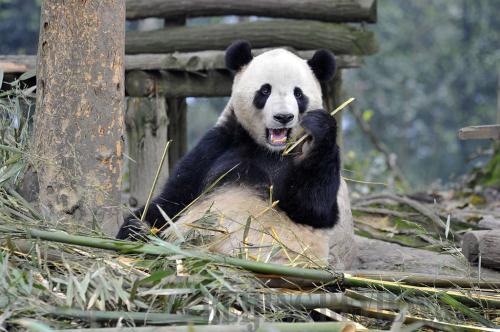|
 |
|
CELEBRITY: American-born Tai Shan eats bamboo at the Bifengxia Panda Base on April 13, 2011. Six-year-old Tai Shan returned to China from the Smithsonian National Zoo in Washington, D.C., in February 2010. His parents, Mei Xiang and Tian Tian, were shipped to Washington from the China's Wildlife Conservation Association on a 10-year loan in 2000 (SHI GANG) |
Currently, there are around 100 giant pandas living in Bifengxia, which consists of a variety of facilities such as a cub kindergarten, a returned panda park, a research center and mating nests.
The mating season is normally from the Spring Festival in January or February to June, which is the busiest time for panda keepers. Apart from the regular duties of feeding, cleaning and observation, they are also required to assist in panda mating, said Gao.
According to Gao, who previously worked at Wolong, the frightened relocated pandas became more dependent upon their keepers. As the environment in Bifengxia was different from that of Wolong, it took time for the pandas to acclimate.
Fortunately, the pandas had gradually grown accustomed to their new habitat as the result of long-term psychological care and diligent feeding.
Gao said the keepers in the base feed the pandas 6 times a day. Their staples are carrots and bamboo in portions according to the panda's weight. If necessary, the diets of weak or distressed pandas are supplemented with other nourishing foods, such as milk.
The wild ones
Currently, there are 300 captive giant pandas all over the world, while the wild ones number more than 1,500.
"China is focusing on protection of wild pandas, including conservation of their habitat and protection and research of the population," Tang said.
"The quake had affected wild pandas, but the impact was not too much," he continued.
He explained that wild pandas normally live in flat areas above 2,500 meters. Panda habitats at this elevation fared better than those under 2,000 meters, because the mudslides caused by the quake were less serious.
The population census of wild pandas is conducted every 10 years. A total of three censuses have been carried out to date. The first one was between 1975 and 1978, followed by a second count from 1985 to 1988. The latest census was led by the State Forestry Administration from 2000 to 2002, with the financial support of the World Wide Fund for Nature (WWF).
It is worth noting that the census played a critical role when regional bamboo forests blossomed unexpectedly in the major habitats of wild pandas in Sichuan, Gansu and Shaanxi provinces in the year of 1974, 1983 and 1993, respectively. Bamboo becomes dry and inedible after blossoming. The population census helped in monitoring the impact and taking rescue measures.
The mobilization meeting for the fourth population census commenced at the end of 2010.
"The preparations for the upcoming census, such as organizing, fund raising and route planning, are now under way," Tang said. "The quake-related research on key programs will definitely be involved this time although it is a regular census."
Tang said the ultimate goal of breeding giant pandas in captivity is to reintroduce the captive ones to nature, to reintegrate their genes and further rejuvenate the entire panda population.
"It takes relatively longer time for the captive ones to develop survival instincts in nature," he continued.
The panda breeding facilities in Wolong and Foping are currently conducting research and training programs.
A rosy plan
For the overall reconstruction planning following the Wenchuan quake, the Chinese Government proposed to rebuild the nature reserves in Wolong and Baishuijiang, relocate the Wolong panda breeding institute, monitor pandas as well as their habitats and put in place an early warning system in the event of a bamboo blossoming season.
According to Tang, the preliminary move of CCRCGP is set to establish three branch facilities: The first one will be located at Wolong for training and implementation of captive breeding and reintroduction of pandas into the wild; Bifengxia will be the second branch for the juvenile panda breeding as the environment is similar to the panda's natural habitat; the third one will be set up at Dujiangyan for disease control and prevention and feeding of aging pandas.
Under the current schedule, most of the giant pandas living at Bifengxia Panda Base will return to Wolong by the end of 2012.
(Reporting from Bifengxia Panda Base, Sichuan Province) | 